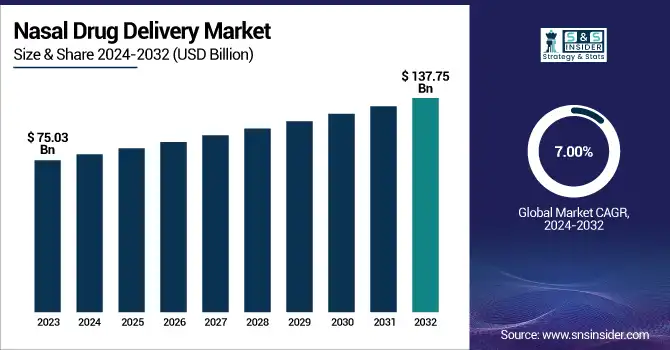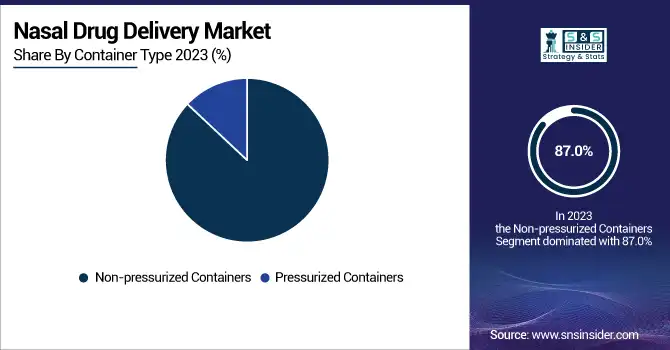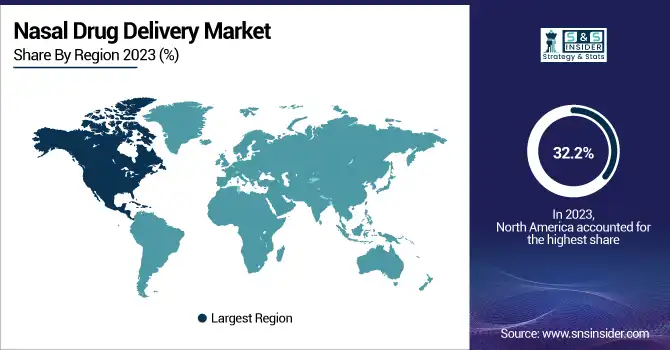Nasal Drug Delivery Market Report Scope & Overview:
The Nasal Drug Delivery Market was valued at USD 75.03 billion in 2023 and is projected to reach USD 137.75 billion by 2032, growing at a steady CAGR of 7.00% from 2024 to 2032. This report highlights the role of technological innovations in nasal drug delivery systems, including advancements in drug formulation and device design that enhance patient experience and efficacy. The study also examines the evolving regulatory landscape, with trends in approval processes influencing market entry and product development. Patient adoption and behavior trends are explored, focusing on the growing preference for convenient, non-invasive treatments and the shift towards over-the-counter (OTC) nasal products. Additionally, the report addresses cost trends and their economic impact, considering factors such as affordability and insurance coverage, while also discussing the rising growth of the OTC market driven by consumer demand for self-care solutions.

Get More Information on Nasal Drug Delivery Market - Request Sample Report
Market Dynamics:
Drivers
-
The nasal drug delivery market is growing due to the rise in chronic diseases like asthma and rhinitis, increasing demand for quick treatments.
Nasal drug delivery systems provide a fast, non-invasive route, which is especially advantageous for the management of symptoms of these long-term diseases. Since nasal sprays and drops are non-invasive, many patients prefer not to use injections. Moreover, the rapid onset of action from nasal drug delivery systems provides a good alternative for conditions requiring rapid relief, such as nasal congestion or migraines. Technological advancement in nasal delivery devices, including more precise pumps and metered-dose systems, further enhances market growth through improved delivery accuracy and convenience for patients. In addition, increased consumer awareness and the availability of over-the-counter nasal treatments have made these products more accessible, further driving the market's expansion.
Restraints
-
Limited drug options, side effects, awareness gaps, and regulatory hurdles hinder market growth.
Many drugs have problems related to formulation: they may degrade, and thus be unstable in the nose, or they do not absorb easily from the nasal mucosa. There is also a lack of awareness in many areas of the world about the benefits and availability of intranasal drug delivery systems. Side effects, such as nasal irritation or damage to the mucous membranes, may also limit the use of nasal delivery systems, particularly for long-term treatments. Furthermore, regulatory challenges related to the approval of new devices and biologics could delay the introduction of innovative nasal drug delivery options. Overcoming these obstacles is essential to fully realizing the market’s potential.
Opportunities
-
Emerging markets, personalized medicine, and technological advancements drive growth in nasal drug delivery systems.
Personalized medicine is another emerging opportunity, as the demand for customized drug formulations and dosage systems grows. This approach can be personalized to the patient's needs and can provide better treatment. The biologics and insulin delivery through nasal systems are promising alternatives for patients who need something different from the injections. With advances in technology and device innovation, there are also opportunities to improve nasal drug delivery devices, such as incorporating sensors for dose tracking or enhancing the delivery efficiency of certain medications. A shift towards home care and the associated increased demand for home-based nasal treatments are creating further opportunities in this market space, especially in terms of easier-to-use self-administration products.
Challenges
-
Formulation issues, patient adherence, competition from alternatives, and regulatory inconsistencies impact market expansion.
One of the major challenges is formulation issues, as not all drugs are suitable for nasal administration due to issues with absorption, stability, and potential irritation of the nasal passages. Patient adherence also remains a concern, as proper and consistent use of nasal devices requires correct technique and regular dosing, which can be difficult for certain patient groups, particularly the elderly or children. Other competitors for drug delivery methods are oral tablets, injectables, and inhalers, for instance; these are often more intuitive and easier for patients to use. Another limitation is that newer nasal drug delivery devices and formulations can be relatively expensive, thereby limiting access to those products for most lower-income patient groups. Lastly, the failure of uniform regulatory standards on nasal drug delivery systems in a few regions may cause the products' delay in approval. As such, manufacturers would find it challenging in introducing new devices and assuring safety and consistency in their offerings.
Segmentation Analysis:
By Dosage Form
The nasal Spray segment dominated the market for nasal drug delivery in terms of revenue with a share greater than 38.0% in 2023. Such dominance is contributed by the massive adoption of the product, preferred for its simplicity of use and convenience, among other factors, with a quicker onset of action. Nasal sprays have been widely prescribed for the treatment of nasal congestion, allergies, and sinusitis, providing swift relief. Their compact size and portability allow them to be used on the go, thus significantly contributing to their popularity with consumers. Another advantage of nasal sprays is that they administer the right dosage of medication, ensuring that a specific amount is delivered to the targeted area. The nasal drop segment, while holding a smaller market share, is estimated to grow at the fastest rate, particularly due to its effectiveness in treating specific conditions in pediatric and geriatric populations. Nasal drops offer a gentler alternative for patients who may find nasal sprays uncomfortable or difficult to use, further boosting their demand in these patient groups.
By Container Type
As of 2023, Non-pressurized Containers held the largest share of the revenue in the nasal drug delivery market with more than 87.0%. These containers are widely accepted due to their simplicity, safety, and cost-effectiveness. Non-pressurized containers are used in most products like nasal drops and gels, as they do not employ the complex mechanisms of a pressurized system. It is also considered more user-friendly and relatively cheaper for both manufacturers and consumers. This ease of use and lower production cost make non-pressurized containers the preferred choice for a wide variety of nasal drug formulations. Although holding a relatively smaller market share, pressurized Containers are estimated to witness significant growth. They are more effective in dispensing metered doses of medicine, which makes them ensure a precise administration. Pressurized containers are significant for products such as inhalers and other delivery systems that are specialized and need controlled drug release. These types of containers offer enhanced efficiency in drug absorption, which is driving their growing market demand, particularly in respiratory treatments.

By Therapeutic Application
In 2023, the Rhinitis segment had a dominant market share of over 34.0%. Rhinitis is a common, chronic condition, and millions of people worldwide are affected by this condition, which includes allergic rhinitis. Nasal drug delivery systems like sprays and drops are efficient in providing immediate relief against symptoms such as congestion, sneezing, and itching. The high prevalence of rhinitis, along with the convenience and fast relief offered by nasal drug delivery products, has driven the segment's dominance in the market. Patients suffering from allergic rhinitis do particularly well with nasal sprays, which act quickly against them, either to target and reduce inflammation in the nasal passages or reduce the attack frequency of the ailment. On the other hand, the Asthma segment is expected to grow at its fastest rate. Nasal drug delivery systems for asthma are gaining attention as an alternative method to deliver medication, such as corticosteroids or bronchodilators. These products help manage airway constriction and inflammation, especially in patients who may not tolerate inhalers well, offering a growing niche in asthma treatment.
By Distribution Channel
In 2023, Retail Pharmacies held the largest share of the nasal drug delivery market through distribution channels. The retail pharmacy segment benefits from the widespread availability of over-the-counter (OTC) nasal products, such as nasal sprays and drops. These products are easily accessible to consumers, allowing them to self-medicate for common conditions like nasal congestion, allergies, and rhinitis. Retail pharmacies are convenient, as customers may purchase nasal treatments over the counter without needing prescriptions. This accessibility and customer demand for easily available treatments has made it easy for retail pharmacies to lead in the market. Online pharmacies have also been a driving factor of this trend as they allow consumers to order nasal products from home. The Hospital Pharmacies segment accounted for the second-largest share in 2023. Hospital pharmacies are important for more specialized nasal treatments, especially for patients with chronic conditions such as asthma and sinusitis. However, retail pharmacies are the most dominant distribution channel because of their accessibility, broad product range, and convenience for the general public.
Regional Analysis:
North America was the largest contributor with 32.2% share in 2023, primarily driven by the high prevalence of chronic diseases like rhinitis, asthma, and sinusitis, as well as the strong healthcare infrastructure. The U.S. is a major contributor, where there is a significant demand for over-the-counter nasal products due to the high adoption rate of nasal sprays and drops. The presence of leading pharmaceutical companies and advanced drug delivery technologies also supports the region's market growth.
Asia-Pacific is expected to lead the growth rate in the future, driven by expanding healthcare access, rising healthcare expenditure, and an increasing burden of respiratory and allergic diseases. Countries like China and India have a large population base and an increasing healthcare requirement, which creates a high demand for nasal drug delivery. Apart from this, the growing healthcare infrastructure in the region and the introduction of low-cost nasal treatments are further adding to the growth of the market in this region.

Get Customized Report as per Your Business Requirement - Request For Customized Report
Key Players:
-
GlaxoSmithKline PLC (Flonase, Avamys)
-
AstraZeneca PLC (Symbicort, Bevespi Aerosphere)
-
Pfizer, Inc. (Nasonex, Nasacort)
-
OptiNose, Inc. (Xhance, Onzentra)
-
Becton, Dickinson, and Company (BD Veritor System)
-
Promius Pharma, LLC (Zembrace SymTouch)
-
Cadila Pharmaceuticals Ltd. (Otrivin)
-
B.F. Ascher & Company, Inc. (NasalCrom)
-
PendoPharm, Inc. (Rhinocort)
-
Douglas Pharmaceuticals Ltd. (Actifed, Rhinocort)
Recent Developments:
-
In Oct 2024, Aptar Pharma acquired the device technology assets of SipNose, enhancing its intranasal drug delivery portfolio. This acquisition allows Aptar Pharma to expand its offerings in the nasal drug delivery market, further strengthening its position in the industry.
-
In June 2024, Aptar Pharma, a leader in drug delivery systems, successfully collaborated with the International Pharmaceutical Industry (IPI) Academy to host a one-day workshop titled “Delivery of Biologics to the Nasal Cavity – the Future of Nasal Drug Delivery.” The workshop took place on June 4th, 2024, focusing on advancements in nasal drug delivery technologies.
| Report Attributes | Details |
|---|---|
|
Market Size in 2023 |
USD 75.03 Billion |
|
Market Size by 2032 |
USD 137.75 Billion |
|
CAGR |
CAGR of 7% From 2024 to 2032 |
|
Base Year |
2023 |
|
Forecast Period |
2024-2032 |
|
Historical Data |
2020-2022 |
|
Report Scope & Coverage |
Market Size, Segments Analysis, Competitive Landscape, Regional Analysis, DROC & SWOT Analysis, Forecast Outlook |
|
Key Segments |
• By Dosage Form [Nasal Spray, Nasal Drop, Nasal Gel, Nasal Powder] |
|
Regional Analysis/Coverage |
North America (US, Canada, Mexico), Europe (Eastern Europe [Poland, Romania, Hungary, Turkey, Rest of Eastern Europe] Western Europe] Germany, France, UK, Italy, Spain, Netherlands, Switzerland, Austria, Rest of Western Europe]), Asia Pacific (China, India, Japan, South Korea, Vietnam, Singapore, Australia, Rest of Asia Pacific), Middle East & Africa (Middle East [UAE, Egypt, Saudi Arabia, Qatar, Rest of Middle East], Africa [Nigeria, South Africa, Rest of Africa], Latin America (Brazil, Argentina, Colombia, Rest of Latin America) |
|
Company Profiles |
GlaxoSmithKline PLC, AstraZeneca PLC, Pfizer, Inc., OptiNose, Inc., Becton, Dickinson and Company, Promius Pharma, LLC, Cadila Pharmaceuticals Ltd., B.F. Ascher & Company, Inc., PendoPharm, Inc., Douglas Pharmaceuticals Ltd. |

